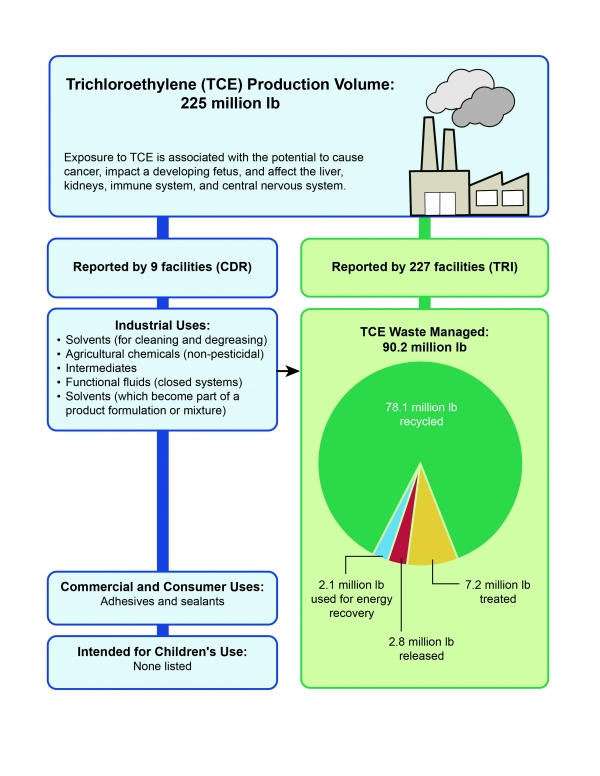Example: TSCA and TRI Information for Trichloroethylene in the 2015 TRI National Analysis
See All Graphics in this Section
Under the Toxic Substances Control Act (TSCA), EPA collects information about the manufacture, including import, and use of chemicals in U.S. commerce through the Chemical Data Reporting (CDR) rule. This information on the production of chemicals complements the Toxics Release Inventory (TRI) data on the management of chemical waste (including releases, recycling, and source reduction). To illustrate how TRI information complements the TSCA chemical assessments, one chemical, trichloroethylene (TCE), is presented as an example.
EPA has undertaken efforts to reduce the risks TCE poses to public health and the environment. For example, EPA has conducted a risk assessment; initiated a rulemaking to eliminate the risk of TCE in aerosol degreasers, as a spotting agent at dry cleaning facilities, and in vapor degreasing operations; and coordinated a voluntary phase out of TCE in arts and crafts spray fixative product marketed to consumers.
Utilizing the chemical information reported to TRI and collected under the CDR rule together provides a more complete picture of a chemical’s lifecycle from sources of import and domestic manufacture to means of final disposition in the environment or products, as shown in this figure.
 In 2011 (the most recent year of CDR data which was published in 2012), nine manufacturers, including importers, reported a total production volume of 225 million pounds of TCE manufactured. Industrial uses reported include as a solvent or intermediate in chemical manufacturing. During the same year, 227 facilities filed a TRI form for TCE, reporting a total of 90 million pounds of waste, most of which (87%) was managed through recycling.
In 2011 (the most recent year of CDR data which was published in 2012), nine manufacturers, including importers, reported a total production volume of 225 million pounds of TCE manufactured. Industrial uses reported include as a solvent or intermediate in chemical manufacturing. During the same year, 227 facilities filed a TRI form for TCE, reporting a total of 90 million pounds of waste, most of which (87%) was managed through recycling.
This page was published in January 2017 and uses the 2015 TRI National Analysis dataset made public in TRI Explorer in October 2016.
